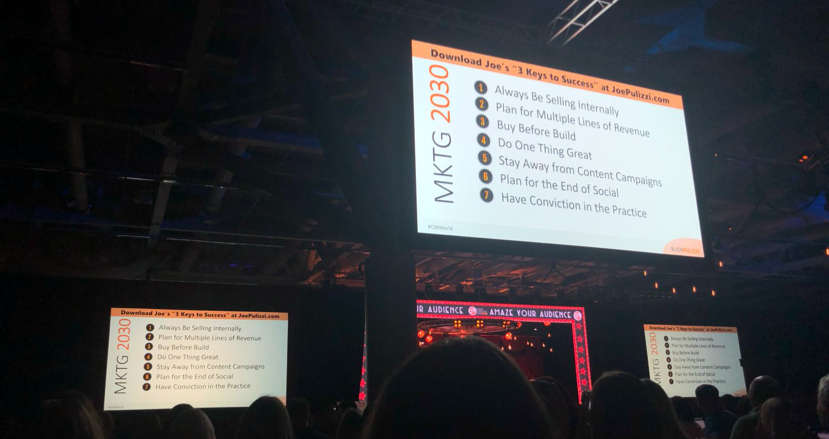The upstart Cleveland conference highlights new ways to reach audiences with content
The advertising industry gathers next week in New York for the 16th annual Advertising Week (Sept. 23-26, #AWNewYork) to figure out how big ideas, big data and the latest tech can make the next generation of advertisements more targeted, memorable, authentic, and experiential. Earlier this month in Cleveland, another group of marketers met for the 9th annual Content Marketing World (Sept. 3-6, #CMWorld) to figure out how they can use search engines, blogs, and emergent mediums like podcasts to make their content production efforts more useful and informative to consumers who are, in many cases, tuning out those aforementioned ads.

Despite differing dispositions towards marketing — one screams proudly from the mountaintops to “buy now” and dazzles us with creative storytelling, while the other soft-sells utility in hopes of building long-term trust — the two practices are converging, judging by the
similarity in conference topics and by the larger industry challenge of a fractured media landscape already drowning in content.
According to the Content Marketing World sponsors, content marketing “…isn’t about being loud or flashy or outrageous. It’s about creating, distributing, and promoting content that solves a business problem or educates or inspires…For marketers today, there’s nothing more important than earning trust and building a loyal audience.”
Joe Pulizzi, founder of the Content Marketing Institute and the first keynote speaker at this year’s conference, presented “MKTG 2030: 7 Laws of Content Marketing”, which alluded to some of the inherent tension between content marketing and advertising. Here are the laws Pulizzi presented, followed by hypothetical responses from the advertising community.
Content Marketing Law 1: Always Be Selling Internally
The Rationale: Also known as the “law of executives who don’t know what they’re doing”, Pulizzi urged content marketers to continually and clearly articulate their elevator pitch about their content marketing program to stakeholders, and to back up that pitch with data so the importance of the investment is understood. Without the skillset to communicate effectively to executives, even the best work is doomed to fail, warned Pulizzi.
The Ad Industry’s Retort: “Pitching to executives? We invented the pitch. If you need help selling in your content marketing program, you’ll need us.”
Content Marketing Law 2: Plan for Multiple Lines of Revenue
The Rationale: Create content with the expectation that it will generate additional revenue on top of your core business like Red Bull did when it diversified its product (energy drinks) with monetizable extreme sports content. Or, use your content as a springboard to generate new
sources of revenue like Buzzfeed did when it diversified its content stream with a food line called Tasty.
The Ad Industry’s Retort: “That sounds more like business strategy. Come back to me when you have a creative brief.”
Content Marketing Law 3: Buy Before Build
The Rationale: If you’re going to start or expand a content program, why not just acquire the assets of a failed publisher at fire-sale costs? Pulizzi cited the failed sports publication, Grantland, as a perfect example of a digital magazine that should have been acquired by a fitness brand. It’s far wiser and less risky to acquire an existing audience than to build it from scratch, Pulizzi noted.
The Ad Industry’s Retort: “You can buy all the publications in the world, but how are you going to drive traffic there?”

Save money, save time: acquire publication assets on the cheap to build out your program.
Content Marketing Law 4: Do One Thing Great
The Rationale: Also known as the “law of Ryan Seacrest”, Pulizzi is not a fan of diversifying content types just for the sake of diversifying content types. If you do produce a diverse stream of content types, use analytics to determine which are most effective. Then prune them down
to what works and place your chips on those. We must do one thing great as content creators, Pulizzi reminded the audience.
The Ad Industry’s Retort: “That’s why we focus on the message before the medium.”
Joe Pulizzi asks marketers to focus on doing one thing great when creating content.
Content Marketing Law 5: Stay Away from Content Campaigns
The Rationale: The goal should be to create better customers who stay longer and who are rewarded for their loyalty. In other words, don’t promote a sale that attracts random, one-off purchases based on race-to-the-bottom values such as price or free delivery. Instead, reward your best customers with promotions after you’ve illustrated your value to them. Adopt a “content forever” mentality and not a seasonal or time-boxed mentality with your content.
The Ad Industry’s Retort: “Oh please, campaigns capture the cultural zeitgeist. Nothing lasts forever.”
Content Marketing Law 6: Plan for the End of Social
The Rationale: Rely on social media at your own risk, as you are only renting space on sites that are driven by motives that may not, in the long run, align with your own company’s goals and will become places where it is increasingly difficult to organically surface content. Make sure your owned channels (email, website, apps) are the focus of your efforts.
The Ad Industry’s Retort: “#goodPoint #weLoveSocial”
Content Marketing Law 7: Have Conviction in the Practice
The Rationale: Also known as the “content marketers are pushover law”, Pulizzi urges his followers to learn the fine art of saying “no” to content creation requests that don’t ladder up to a larger strategy or are just created to appeal to a stakeholder without being backed by data.
The Ad Industry’s Retort: “Sure, but just remember sometimes saying ‘no’ can be the end of a relationship.”
